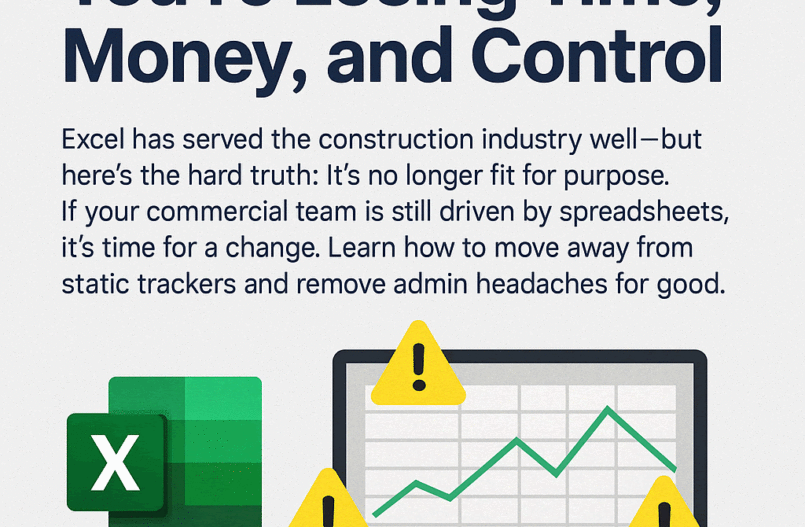Excel has served the construction industry well – for decades. It’s helped commercial teams track costs, log variations, forecast spend, and manage project data in a simple, no-frills format.
But here’s the hard truth: it’s no longer fit for purpose.
If your commercial operation is still driven by spreadsheets, you’re probably:
-
Reacting to problems instead of anticipating them
-
Struggling to find the latest version of critical information
-
Duplicating effort across teams
-
Leaving margin on the table
And the most dangerous part? You don’t realise how much time, and value – you’re losing, because Excel doesn’t show you what you’ve missed.
🚧 Where Excel Falls Short
Excel is a fantastic tool for calculations, lists, and ad hoc reports. But construction delivery is dynamic. Multiple teams, moving targets, hundreds of touchpoints – Excel wasn’t designed for that.
Common pain points we see:
-
No approval workflows – You can’t see who’s approved what, or where a decision is stuck.
-
No live collaboration – Teams work on different versions. You lose track.
-
Manual updates – Every time a figure changes, someone has to remember to update 3 other tabs.
-
No integration – Cost data, site data, programme data… all in silos.
-
No reminders or triggers – Variations, early warnings, or payment notices go cold because nobody was nudged.
This isn’t a tech problem. It’s a visibility problem.
🛠️ Real-World Example: From Excel to Systematic Control
A subcontractor we worked with managed all variation tracking through an Excel workbook. It lived on the commercial manager’s desktop. Only he updated it. Every month, he manually sent PDF snapshots to the client.
Things slipped through. Claims were submitted late. Approvals were missed. The commercial team was frustrated. The site team stopped trusting the tracker.
We built them a SharePoint-based tracker with Power Automate workflows. Now:
-
Site staff log variations through a web form
-
Every entry is date-stamped and saved
-
Documents are auto-generated in Word
-
Approvals are tracked
-
A Power BI dashboard gives live summaries across all projects
Within 4 weeks, they’d uncovered over £50,000 in missed value – just from standardising what they already knew.
🧭 How to Start Making the Shift
You don’t need to “go digital” overnight. You just need to remove the biggest points of failure – and automate the repetitive admin that’s holding your team back.
Here’s a simple, scalable approach:
1. Pick One Process
Start with something painful but manageable – like variation logging or approvals. Don’t try to systemise everything at once.
2. Map It Clearly
Who submits? Who checks? Who approves? Where is the data stored? How is the record kept? If you can draw it on a whiteboard, you can automate it.
3. Build It in SharePoint or Teams
If you already have Microsoft 365, you already have the tools. Use SharePoint Lists, Power Automate, and Power BI – no code required.
4. Set Alerts and Deadlines
Make sure the system reminds people when something is pending. No more “I didn’t know that was waiting on me.”
5. Review and Refine
Test it. Get feedback. Improve it. Make the system work for your team, not against them.
🔚 Final Thought
This isn’t about replacing people. It’s about freeing them up to think commercially – not chase paperwork.
If your commercial team is spending more time formatting Excel than forecasting value, it’s time for a change.
Excel helped you get here. But it won’t take you where you’re going.


